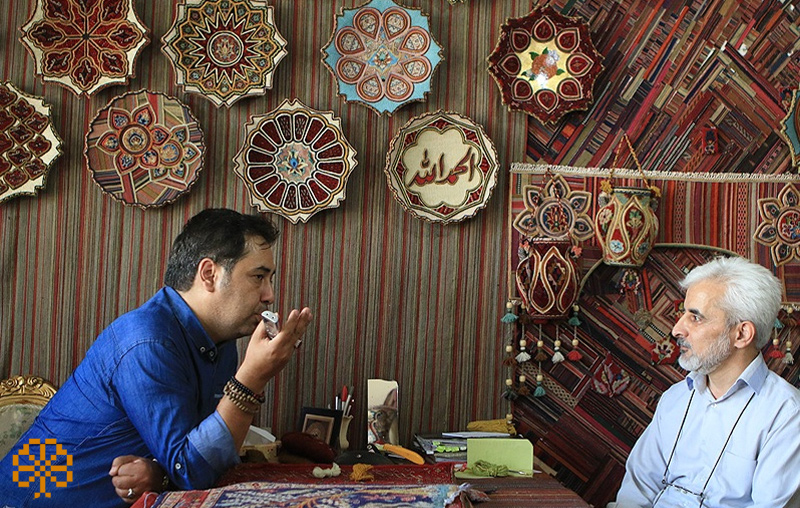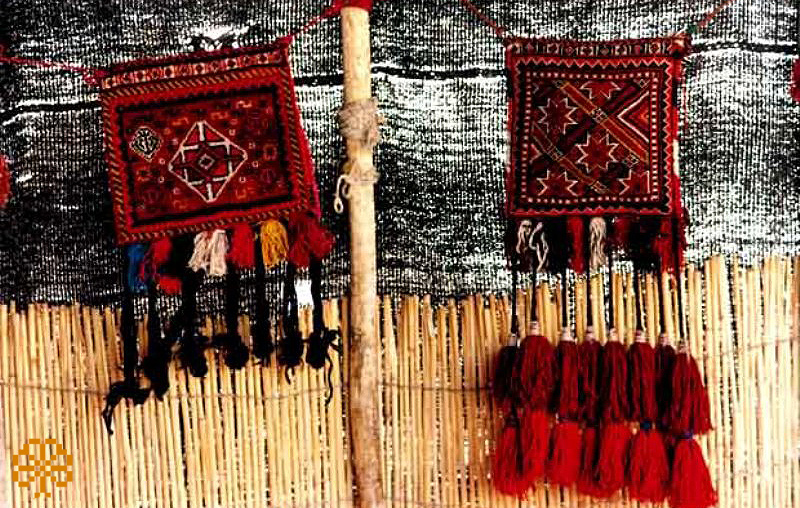What is handmade or chint-weaving carpet mosaic?

Handmade carpet mosaic is one of the newest handicrafts that may not have been introduced as much as it should be among art lovers. Hand-woven carpets, due to their special originality and beauty, have led to their use in various arts, of which mosaic or chint weaving is one of the most beautiful works of art.
In this article from Farahan Carpet, we intend to study the mosaic art of handmade carpets in detail, and after a general review of the history of this art, we will examine how to do it.
History of handmade carpet mosaics
Handmade or chint-weaving carpet mosaic is one of the newest options among the visual arts, which is nearly 20 years old. According to studies, the creator of the mosaic is Mr. Ali Akbarullah Verdi.
Allah Verdi started working on carpets in 1982, and for the first time the idea of using pieces of carpet on different dishes came to his mind. At the beginning of his career, he tried to register this art under the name of “Volume Art”, but with the opposition of the officials in this field, he was forced to choose another name for it, which was “chint weaving”.
Chinteh weaving was chosen for this art against the will of God and by the officials, and he emphasizes that he likes to use the name of handmade carpet mosaic for his work of art.
At first, this art became famous and was seen by the public by using religious and Quranic subjects and especially by using the verse “In the name of God, the Most Merciful”, but today, due to the modernization of home decorations, there are many different designs for this. And the creation of this visual art is used.
How to do carpet mosaic
As we mentioned in the previous section, in handmade carpet mosaics, you use pieces of handmade carpets and use it on various dishes and equipment.
Of course, not only carpets are used for this, and the use of jajim and kilim is also very common. In general, it can be said that you can benefit from bears and fluff to high carpets in carpet mosaics.
If you are planning to start this, you need to know that in addition to the pieces of carpet, you also need other equipment and raw materials, the most important of which are; Scissors, wood glue, iron glue, pliers, needles and merino wool.
The quality of carpet mosaic work depends on two main factors; The first is the type of carpet used and the second is the cleanliness and accuracy of the work. For example, one of the most common defects in bagging is the presence of seams between the glued pieces and the device.
If you are going to buy a handmade carpet mosaic, in addition to checking the seams, you need to pay attention to the beginning and end of the used mosaic work. A good carpet mosaic can never be identified at the beginning and end of its work. The next thing is to pay attention to the symmetry of the work done and the designs used must be consistent with the device.
Read more: Carving handmade carpets at home and step-by-step instruction
Suitable carpet weaving
As we said, you can use handmade carpets, rugs and kilims for carpet mosaics and determine the quality of the type of carpet depending on the cost and cost of the work.
But there is a general rule and standard, and that is the use of carpets over 40 knots for mosaics. The more you increase the amount of ridge, of course, the higher the quality of your work and also the price will increase by the same amount.
So it can be concluded that the type of customer order is very effective in choosing your carpet. It is better to know that if you are looking for a shiny mosaic, you need to use carpets woven with fluff, and if you are looking for a delicate and colorful mosaic, you should use silk carpets.
Bagging is different from bagging !!
So far we have reviewed everything you need to know about handmade or baggy mosaics, but it is interesting to know that we have another type of handicraft and visual arts called bagging in addition to bagging!
A bag is a kind of sack, bag or bag that is used to store various items in nomadic life. The bag usually has a handle that is woven from the yarn of the bag itself and is used to hang it from a point or throw it on the shower.
This work of art is mostly used for storing mirrors, combs, Quran, spoons, threads and needles and sewing accessories, carrying food on the move and the like.
Of course, over time, the use of bags is decreasing day by day, and today its use has become more decorative and is used in cars or home decoration.
The designs used for bag weaving are mostly using the names of imams, bird motifs and domestic animals, and in a way, by seeing them, you can fully feel the sense of freshness and nature from them.
Economy of handmade carpet mosaics
Carpet mosaic art can generate high income due to creating a beautiful and special work of art. We all know that Iranian handmade carpets are very well known among the countries of the world and have many customers. Carpet mosaic is very similar to carpets in terms of characteristics and can be a very attractive option for export.
One of the most prominent characteristics of carpet mosaic art is that it has a very high variety of work and its designs are not duplicated in any way. This makes this art able to satisfy different tastes.
This art is new to other Iranian handicrafts and can be a source of income for different sections of society, especially housewives, with the right investment.
One of the main problems with carpet mosaics is that the Cultural Heritage Organization has not yet accepted it as one of the arts of handicrafts. If that happens then it will definitely increase the support and spread of this wonderful art.
In this article, we have tried to examine in detail everything you need to know about the art of handmade carpet mosaics. If you have a question or a point about what has been said, you can share it with us in the comments section.







